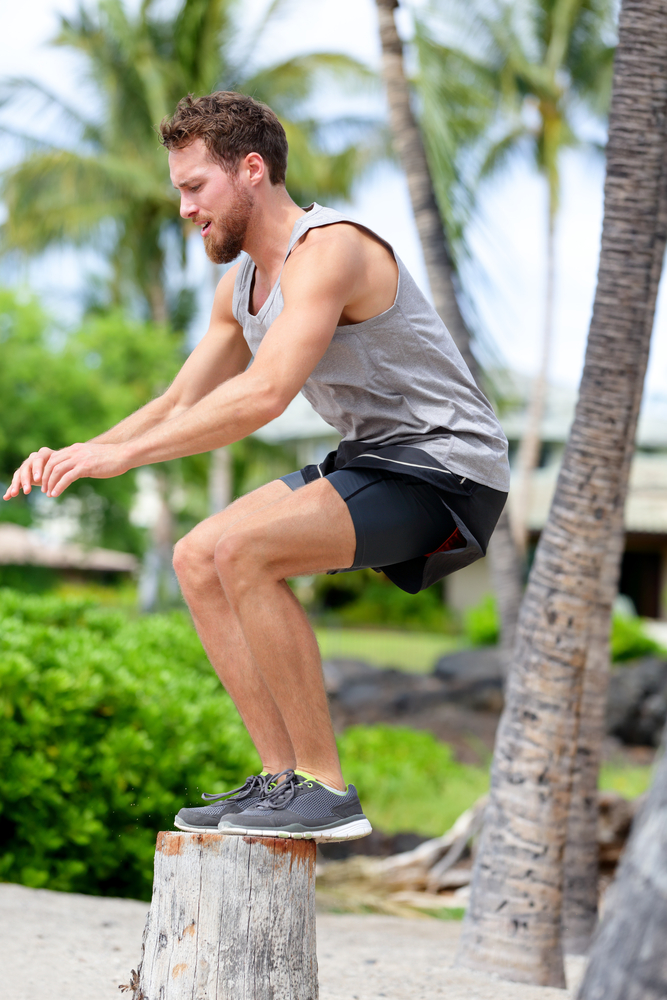How to Fly: The University of Utah’s basketball strength coach gives some tips on improving your vertical leap.
There is a lot of advice out there about how to get a better vertical leap. Weird shoes, intense month-long programs and more promise to send you flying, but a lot of that is nonsense. Ute men’s basketball strength coach Charles Stephenson explained to us the real essentials to jumping higher.
1. The foundation of a good vertical is strength
Don’t skip leg day of course, but remember that jumping is really a full body movement, Stephenson says. Complete weight training must be an integral part of increasing your vertical.
That said, there comes a point when strength isn’t enough. Different types of exercise are needed to increase the power behind your jumps.
2. Add resistance to your jumping workouts
Use dumbbells or weighted vests to add resistance to a jumping workout.
Example: Squat Jumps with Dumbbells:
Start with light weight. Bring feet shoulder-width apart. Squat to sitting position and explode upward.
Some advise against this workout because of the safety implications. The landing is where problems can occur. Land first with your toes, then your mid-foot should hit, then your heel. Then absorb the shock with a balanced bend of the knees.
Landing properly also allows for quick recovery and explosion into your next jump. Jumping in quick succession is the best way to do squat jumps, Stephenson says, but learn correct form, take it slow and use light weight or no weight to start out.
In addition, make sure to use different weight amounts as you progress. Train your body to jump against varying levels of force, and you’ll be more prepared for jumping in a basketball game, soccer game or any other physical activity.
3. Do resistance jumping on one foot
Athletics often demand jumping off one foot, not two.
Ex. Rear Foot Elevated Split Squat Jumps
Using small stool to support one foot behind you, do single-leg squat jumps. Your rear foot stays stationary during this workout, but the landing and jumping motions should be the same. Warning: this is a difficult exercise, even without weights. Start with just your body weight, and add vest or dumbbell weight over time.
4. Add assisted jump exercises
This may seem counterintuitive, to do jump exercises that are easier than body weight or resisted jumps, but as Stephenson explains, assisted jump exercises train your muscles to contract faster. For the same reason, athletes do over-speed running workouts, where a bungee or cable makes them run faster than their normal sprint speed.
Ex.: Assisted squat jump
This exercise will require ropes or TRX bands that come down from above your head to about chest height. Standing directly beneath the bands, do squat jumps, using your hands and arms to assist the jump. Jump in repetition. The bands can also be used to do assisted one-foot squat jumps.
5. Don’t stop doing body weight jump exercises.
Incorporate body weight squat jumps and other exercises into your vertical leap training. You’re trying to enhance your natural jumping ability, so your body needs to experience natural motion frequently.
In summary: 3 workout varieties help you get a better vertical:
• Strength Training: to produce more force.
• Resistance Jump Workouts: to produce more power.
• Assisted Jump Workouts: to train muscles to contract faster.
Stephenson says the men’s Utah basketball team uses all three of these varieties regularly in their training.
Why to Push Yourself
When we get older, we start to lose some of our athletic ability, says Stephenson, who has worked as a strength and conditioning coach at four universities now.
“But a big reason why people can’t run fast or jump high anymore,” he says, “is because they’ve stopped ever trying to run fast or jump high.”
Life gets busy, and people stop utilizing the body’s full potential. That is when the body starts feeling old—when it starts getting slow due to under use.
And it isn’t just about increasing your physical capabilities, Stephenson says. It’s a psychological benefit to push yourself, to know that you can do hard things.
“You’re body is amazing,” he says. “Use it.”
But, this must be taken with a grain of salt. Don’t push yourself beyond your abilities.
